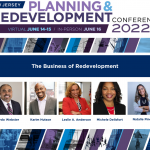New Jersey Future Blog
Examining the Influence of 50 years of Hip Hop on Planning and Redevelopment
July 18th, 2023 by Michael Atkins
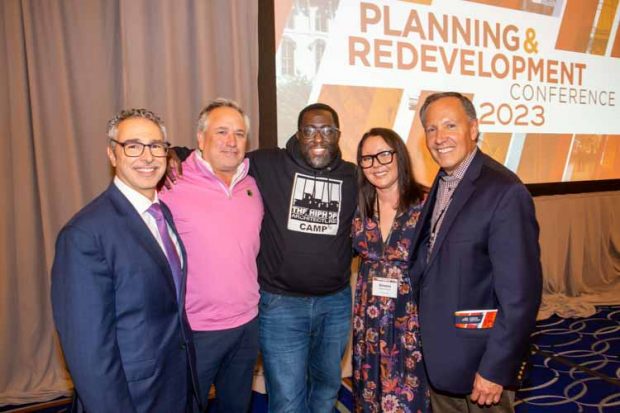
From left to right: Peter Kasabach, Executive Director, New Jersey Future; Charles Latini, President, American Planning Association – NJ Chapter; Michael Ford, Founder, BrandNu Design Studio; Sheena Collum, Executive Director, American Planning Association – NJ Chapter; Thomas Dallessio, Vice President of Policy, American Planning Association – NJ Chapter . Photo by Frank H. Conlon
On the occasion of hip hop’s 50th birthday, media companies, nonprofits, and the general public are charting the massive influence of this musical and cultural phenomenon on all aspects of modern life. This was no different at the 2023 Planning and Redevelopment Conference, co-hosted by New Jersey Future and the American Planning Association NJ Chapter, where two sessions addressed hip hop and its intersection with planning and architecture.
As the keynote speaker at the conference’s third and final day, Mike Ford captivated the audience by sharing his perspective and life experience as a hip hop architect. Ford began by reaching back a century ago to tell the story of Black influence on architecture, pointing to an infamous, albeit problematic, rendezvous between jazz great Josephine Baker and her unrequited and unscrupulous admirer, Le Courbusier. “Jazz is more advanced than architecture…if architecture were at the point reached by jazz, it would be an incredible spectacle,” Le Corbusier observed in the height of his obsession with Baker, whom he met on a cruise while the singer was a major performer in 1920s Paris. To mark this chance encounter that altered the trajectories of both music and architecture, Ford led the attendees through a sing-a-long rendition of Biz Markie’s “Just a Friend”.
Ford then launched into a pointed but popular criticism of modern planning and design, pointing to the massive attention paid in today’s society to conduct proper, inclusive outreach across racial lines, while hip hop as an art form has chronicled the history of dispossession, economic exclusion, and the built environment throughout its entire history. “As design professionals, if we can listen to the words of hip hop artists, then we can listen and see the criticisms they have been raising for 50 years and counting.”
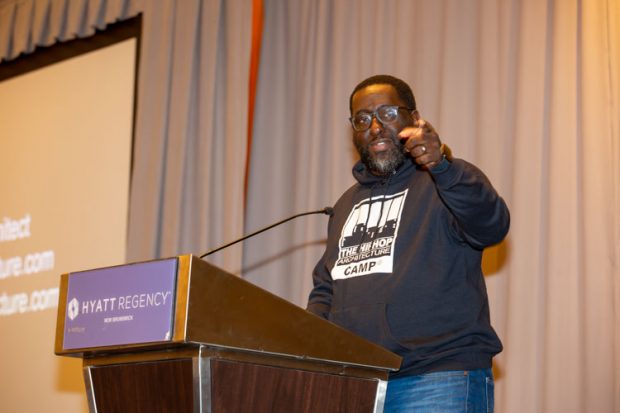
Michael Ford, Founder, BrandNu Design Studio, speaking during the 2023 NJ Planning and Redevelopment Conference. Photo by Frank H. Conlon
“Hip Hop is a reflection of the built environment.” – Mike Ford
Ford recounted his various endeavors working with youth cohorts to address the built environment. Hip Hop Architecture Camp introduces young people to architecture through a culturally relevant pedagogy. Young people deconstruct the lyrics and complexity of hip hop’s rhythm, texture and patterns, construct 3D models, often their first exposure to forming these types of models, of cities to reflect the lyrics of a given hip hop song and compare lyricists, and write their own original rhymes. Ford uses hip hop as a point of access to civic and racial history to engage, for instance, Detroit youth and the history of displacement and segregation through highway infrastructure development.
Ford has participated in a variety of projects throughout North America that have blended hip hop sensibilities into contemporary urban needs. A prominent example being the Universal Hip Hop Museum (Bronx, NY), a mixed use building with the bottom two floors providing space for the museum and a housing complex boasting 526 affordable units above. Ford is also involved in the highly anticipated Black Inventors Hall of Fame, coming to Newark, NJ, to honor the history of their contributions to American history. According to the project’s website, “The museum is envisioned to be a 31,000 sq ft. facility with state of the art, tuition free STEAM classrooms, theater, Metaverse library, startup incubator, and a Legends Hall featuring the top Black inventors of the Golden Era in this country.” As to why these stories must be told through a museum, “Because when you build public spaces, it matters.”
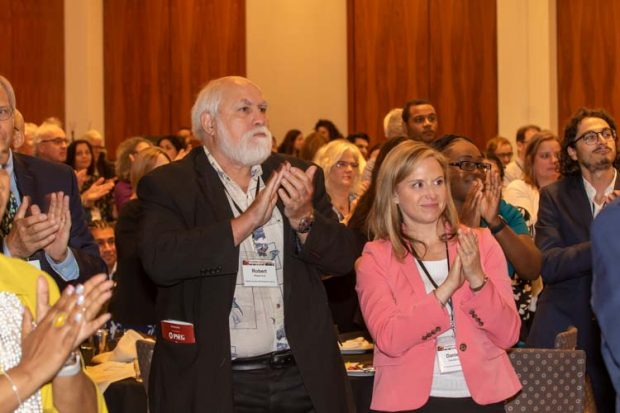
Standing ovation after Michael Ford’s keynote, Hip Hop Beyond Beats and Rhymes, Architecture Beyond Bricks and Mortar, at the 2023 NJ Planning and Redevelopment Conference. Photo by Frank H. Conlon
In conclusion, Mike Ford provided the following closing remarks to a standing ovation: “Hip Hop architecture is not just an idea or academic pursuit. It’s not just whimsical and fun and making curvy [stuff] because it has to be tied to hip hop. To me hip hop sustains life. When you can combine hip hop, architects, and designers, we can do some amazing things. Teaming hip hop artists with humanitarian projects can accomplish great things.”
A second session at the Planning and Redevelopment Conference dedicated to exploring the influence of hip hop was titled, “Hip Hop Will Save Your Life”, featuring speakers LaTricea Adams, Founder CEO & President, Black Millennials 4 Flint; Russell Armstrong, Climate and Environment Policy Director, Hip Hop Caucus; Darren Harris, Founder and CEO, PANN TV; and moderated by Tomas Varela, Executive Director, New Jersey Black Empowerment Coalition.
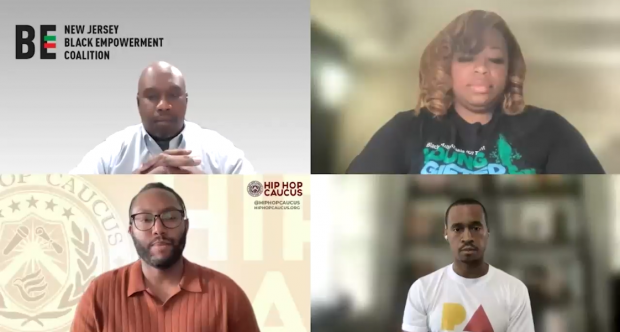
How Hip Hop Will Save Our Life virtual session at the 2023 NJ Planning and Redevelopment Conference. Top row from left to right: Tomas Varela, Executive Director, New Jersey Black Empowerment Coalition; LaTricea Adams, Founder CEO & President, Black Millennials 4 Flint. Bottom row from left to right: Russell Armstrong, Climate and Environment Policy Director, Hip Hop Caucus; Darren Harris, Founder and CEO, PANN TV.
Adams explained why the Flint Water Crisis resonated so deeply and broadly with Black culture and the hip hop community, stating, “While the issue began in 2014, it wasn’t until a year later that most of American became aware of the crisis.” Suspicions among local community members that their majority Black city wasn’t being told the truth about their water supply raised long-standing concerns that challenged the perceived social progress in America, begging the question: Why are we still fighting for the most basic of civil rights?
The Hip Hop Caucus was formed a full decade before the Flint Water Crisis, at that time primarily addressing voting rights before quickly expanding into intersectional issues around environmental and economic justice in the wake of Hurricane Katrina’s devastation, which disproportionately impacted Black communities in the South. On the subject of integrating artists into public campaigns, Armstong noted that artists have to live off of their own fame, but want to speak on issues they care about, whether it be a local water issue or fundraising for relief in the aftermath of a hurricane. Armstrong stated, “Outside of Jackson and Flint, we had a water crisis in NJ. These are issues that the Black community has known about for a long time before the mainstream media picks up on these issues. The same issues we are talking about are the same ones that hip hop artists are passionate about. As the Hip Hop Caucus, we respect that.”
“Nothing wrong bringing the culture into advocacy. Everyone can be involved.” –Russell Armstrong, Hip Hop Caucus
Harris, for his part, has founded and operates a media platform with exactly that capacity. Harris recounted the growth of his online media platform, PANN TV, and their approach of crowdsourcing material pertinent to their audience. He pointed to two prominent examples of the influence of hip hop, both near and far. “At this point hip hop is not just the music, it’s how we look, how we speak, the way we look when we walk into a room. The Mayor of Newark, Ras Baraka, is a representative of the hip hop community…and diaspora.” Harris continued by pointing to the life and legacy of Nipsey Hussel, who, before his murder, was an influential figure in both the musical and his local communities. Hussel was a local icon in South Los Angeles, where he bought real estate, opened businesses and resource centers for youth. Before his death, he took an active role in planning and advising “Destination Crenshaw”, a public private partnership between the city, county metro, and private business to open a mile long open-air celebration of Black Culture in LA along Crenshaw Boulevard, LA’s historic Black commerce district, in conjunction with the expansion of metro service to the airport and newly constructed professional football stadium.
In their concluding remarks, Adams and Harris both encouraged attendees to value artists and Black media in shaping public goods, services, and spaces. Armstrong concurred, advising, “Nothing wrong bringing the culture into advocacy. Everyone can be involved. Every different generation can engage in this work. Folks want to bring their full selves into the work they are doing on a day to day basis.”
Related Posts
Tags: advocacy, architecture, built environment, community, displacement, environmental justice, infrastructure, Redevelopment, segregation





